A Study of Social Media Strategy for Promoting Food Sectors
Dr. Anu Shrivastava
Ms.Jayati Gupta
ABSTRACT
This study examines the success of using social media forums for promoting food sectors and the customer’s reaction towards social media. Social media consists of a variety of online devices where internet users are constructing bonds with other users and firms contributing their ideas, thoughts, and beliefs through blogs, conferences, media relations forums, and social connections. Social media is currently booming and connecting with billions of people across the globe through famous social media connections like Facebook, Instagram, Twitter, etc. Firms across the globe are using these platforms of social media as a technique for promoting food sectors. The online communications used by the firms will lead to promotions in the form of advertising as well as personal selling so that awareness is formed among the consumers, the brand image is constructed, and it can enhance the buying behaviour of the consumers. This will lead to growth in the business. In the past, communication was done by the firms with the help of traditional media like newspapers, magazines, television, and radio. Today, the rise of social media has given firms a platform to communicate more easily than with traditional media. The aim of the current research was to promote the food sector. Food sectors refer to Zomato, Swiggy, Food Panda, etc. using social media for promotional strategies.
Keywords:Social networking sites, Online food sectors, Consumer behaviour, Social relations.
INTRODUCTION
Establishments in India have become the new trend setters and talk-of the-town in the global sectors of economy since the past few years. The upcoming Indian organisations are ready to experiment with a focus on the interests of Indian customers and give them different varieties of food and facilities at a low cost. The tech-savvy youth are geared up with a variety of ideas for their start-ups to capture the mindshare of people with differentiated technology, innovative products, and pioneering services.
The current generation is high on confidence, prefers to lead their lives much more comfortably, and therefore has brought in valuable solutions to improve the lives of others around them. Food is one of the product categories that can be successful in India for a beginner. Nowadays, there are several competitors who are putting all their efforts into winning the hearts of the customers. The food technology is an essence to begin in India. It can be inferred that not only IT but also new ideas in the food industry given by customers can evolve food technology. Not only the technology used by mobile phones and apps, but the advanced process of food technology used to form new food products and the skills of the customers can result in advancement in this field.
In India, online food delivery organisations are becoming huge and are becoming second only to grocery stores in terms of commercial value. The food delivery market in India is increasing in value by 15 billion dollars. Indian markets have become big players in food delivery. The growth of these sectors for online food ordering has created a platform to deliver through mobile apps, which has made men take notice.
Some popular food hubs like Swiggy, Food Panda, Grub Hub, and Hungry House are feeding the world online and making profits. The piping hot Indian food technology industry is slated to reach $78 billion by 2021, growing at 16% year after year. However, the picture is not as rosy as it appears. Despite the vast potential of this sector, many players that jumped into the food tech fray either downsized, like Zomato, or completely shut down. Currently, out of 105 food tech start-ups in India, only 58 are currently operational. In the beginning, the food technology companies started with organisations such as Zomato, which facilitated the search for better restaurants, thus creating a user-friendly forum. The next stage saw companies like Food Panda trying to address the issue of ordering and booking at these restaurants by working as an aggregator.
The next stage had players like Swiggy tackling the issue of delivery in the value chain. Basically food technology till date is making its place in Indian market. It is strange that none of the players have touched the upper part of the food chain, which itself is food. Also, the main reason is that the players who started the food technology have become replicas of each other because they were unable to be unique and creative.
OBJECTIVES
- To study the social media activity for promoting the online food sector.
- To study the relationship between the monthly family income of respondents and the monthly spending on ordering food online.
REVIEW OF LITERATURE
NéstorVercher (2022), regional social advancement cycles can advance new types of communication among makers that work on the effectiveness and coordination of AFNs. The primary factors that make sense of the rise and improvement of these cycles are the particular circumstances and directions of every region (regional capital, socio-segment, and financial construction), the occurrence of a few triggers (which can’t necessarily be predicted), the development of neighbourhood aggregate authorities, the production of participatory and conflict management components, and the ability to scatter advancement to a different scope of actors in the domain, past the underlying extent of AFNs. These outcomes are significant both for entertainers engaged with AFNs and for the public at large, as they make it conceivable to further develop support instruments for AFNs.
Danielle M. Ferraro, Richard S. Cottrell, Gordon D. Blasco, Halley E. Froehlich, and Benjamin S. Halpern (2022) argue that the replacement of maintainable food varieties with other, higher-influence varieties holds incredible promise for diminishing the ecological weights forced by existing food frameworks. However, we found minimal experimental proof for past decreases in the utilisation of food varieties when elective food varieties are presented, proposing that elective food varieties are probably not going to be a far-reaching component for food framework changes. While rare generally, an assessment of the utilisation declines that happened showed that occasions kept an eye on co-occurring with misfortunes in both outright and per capita home-grown creation, demonstrating that dietary change can possibly impact the neighbourhood effects of a country’s food creation. Ideal cases for dietary change by means of elective food varieties will have facilitative circumstances to help elective food reception, as well as areas of strength for the current food.
Dr. Apoorva Prashant Hiray,Dr. Jayashree Vivek Bhalerao, and Dr. Ganesh Ramesh Teltumbade (2022), consequently, it very well may be reasoned that clients of Zomato are happy with the application’s design and its point of interaction, with the updated and exact data on the entrance, with the services conveyed as guaranteed (reliability), and with the security of individual and banking details. However, clients are disappointed with the speedy client care and revised strategy of Zomato. Robotic and AI client service should be supplanted by the actual representatives (talking and calling) to serve the clients better. Additionally, normal criticism should be taken to upgrade the quality. Refunds and substitutions for awful quality food or missing items should be settled rapidly. A stringent move should be initiated against mischievous conveyance specialists.
Qi Zhang, Kayoung Park, Junzhou Zhang, and Chuanyi Tang (2022), WIC OO is still in an early execution stage and has been acknowledged by a few early adopters. Minority families carved out opportunities to take on this advancement. Non-Hispanic dark families had a lower number of OOs compared with non-Hispanic white families. There were huge aberrations in WIC OO reception across sociodemographics.
RESEARCH METHODOLOGY
In this research, the main question is based on how social relations on social networking sites are influenced by performance, organizations, and institutions. Social networking suggests that the behavior of an individual is created by the connectivity of interpersonal relations. There are various networks of public communications and public communities.
Here, I would like to emphasize the significance of the approach taken for this research:
- Primary Data, where a survey based on a questionnaire has been done to show how social media can prove to be useful for the purpose of building strong customer relationships. Instant communication and direct accessibility to the consumer on social sites opens up a plethora of opportunities for the food sector. Specially, in times of crisis and discord arising for different reasons, these can be immediately taken care of.
- Secondary data was accumulated from customer food blogs, newspapers, research articles, and the social media forums of Zomato and Swiggy.
A) RESEARCH DESIGN
Descriptive research is formal as well as functional, as it defines the natural efforts of a clause, difficulty, fact, facility, and agenda through specified hypotheses and examined questions. For instance, the living situation of the groups and defining behaviour concerning a problem (Kumar 2011, 10) Saunders et al. (2007) argue that, in addition, a forefront competitor can be a portion of exploratory research. This is necessary to have a transparent image of the fact, as one has a desire to accumulate information rather than use the stored information. In reality, descriptive research is usually difficult as it needs good potential to accomplish good results (Blumberg et al. 2008).
B) DATA COLLECTION METHOD
When studying the opportunities of qualitative research, various methods are used for accumulating information for analyzing the study of organizational challenges (Blumberg et al. 2008).
In addition to this, Yin (2003) advised that the information from the respondents is profitable and can be used at large with the following rules concerned with the research design:
- Using various sources for testimony
- Keeping record of testimonials
Further, the reason for this research is not to give details about the elements but to focus on the accumulation of data in various ways, like interviews, documents, and archives.
Interviews are usually the best way to accumulate data for proof. However, Blumberg et al. (2008) stated that interviews that are semi-structured involve two major points: One, the desire of the researcher is to get the respondent’s opinion on a problem. Two: The desire of the researcher is to understand the respondent’s perception as well as confirm the data the researcher has received from other respondents.
Documents and Archives: Secondary data and archives are the authentic sources of information, although they are not normally used in study methods. For instance, reports, articles, as well as newspapers, come under this category. Secondary data is supposed to be extremely informative, but it has its limitations. Being in written format, it can prove to be a single perspective (Blumberg et al. 2008).
Another significant supply of data is archives. The examples consist of information from the customer survey, consumer records with comments, and online reviews. Documents and archives will be used from consumers’ graphs and data collected online for this study.
C) DATA COLLECTION TOOLS
The approach of a survey will help to recognize the brand by reaching out to the focus groups, tools of influence, use of social connecting sites, and methodology of interaction. Another approach is content analysis, which involves studying the interactions amongst the top three Indian social networking sites, each with different dimensions, to achieve structured outcomes.
D) SAMPLING FRAMEWORK
The sample size is expected to be convenient. The interviews use a convenient sample size, and the risk in this procedure is that the interviews reach a limited population. The respondents in the interviews will mostly be of similar age. The interviews are also concentrated on the sample size of people using social networking sites for various purposes.
The research on the use of social networking sites by social media for the purpose of the food sector will allow me to understand more about the connected world that forms a large part of its consumer awareness online. A sample consisting of respondents who fall in the age group of 20 to 35 has been incorporated into this research. The interviews will be conducted with 355 respondents. The area for taking interviews will be Mumbai and Navi Mumbai (Maharashtra).
E) CONTENT ANALYSIS
The following three famous social connecting sites were chosen for content analysis to discover efficient brand interaction between consumers (Facebook, Twitter, and Instagram).
F) DATA ANALYSIS METHOD
Information required for the research study regarding “the study of social media strategies for promoting the food sector” is collected through a structured questionnaire. Responses from 355 respondents have been collected.
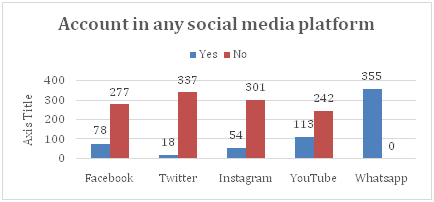
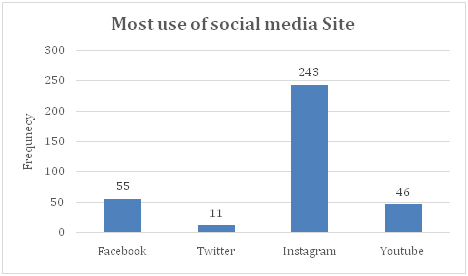
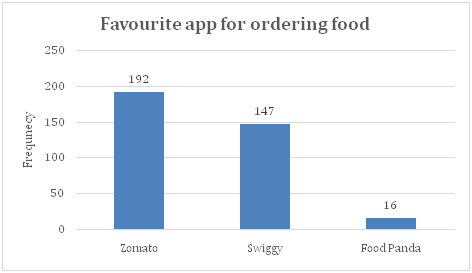
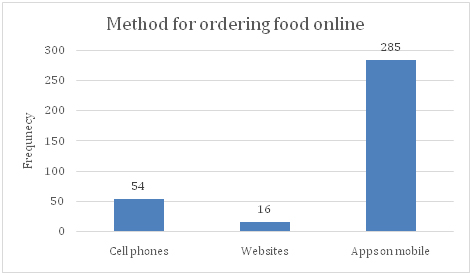
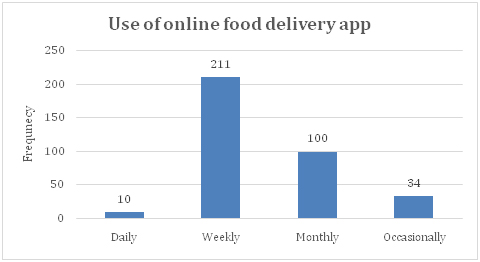
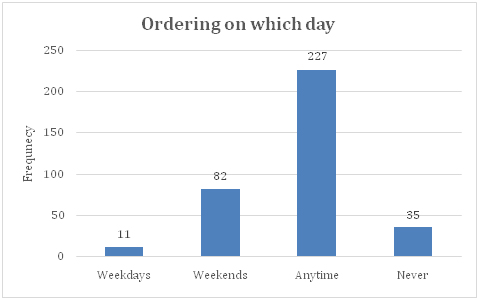
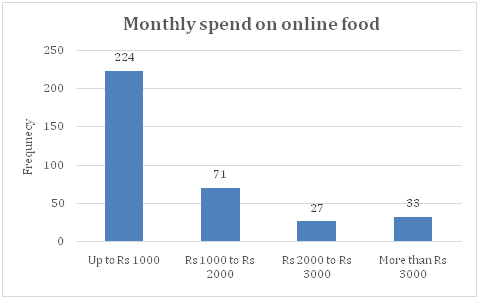
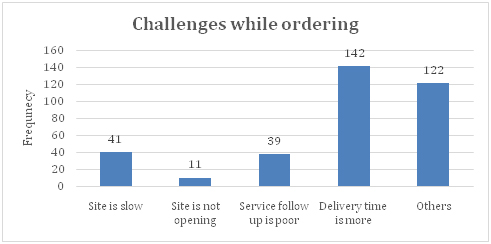
FINDINGS AND SUGGESTION
There is a significant difference in the level of influence of social media advertisements from Zomato, Swiggy, or Food Panda on the respondents. There are respondents who are not influenced at all by the social media advertisements of Zomato, Swiggy, or Food Panda, which is lower than the expected number of 88.8. There are respondents who are partially influenced by the social media advertisements of Zomato, Swiggy, or Food Panda, which is lower than the expected number of 88.8, there are respondents who are somewhat influenced by the social media advertisements of Zomato, Swiggy, or Food Panda, which is significantly higher than the expected number of 88.8, and there are respondents who are mostly influenced by the social media advertisements of Zomato, Swiggy, or Food Panda, which is significantly higher than the expected number of 88.8. This suggests that respondents are mostly or somewhat influenced by the social media advertisements of Zomato, Swiggy, or Food Panda.
There is a significant difference in the overall acceptance of technology according to the age group of respondents. The mean score of overall technology acceptance is highest for the respondents aged below 25 years at 61.71 percent, while it is lowest for the respondents aged above 25 years at 56.73 percent.
CONCLUSION
In this modern world, every firm, especially on social media, is promoting the food sector. As per the study, the food sectors are either using social media since a long time or planning to use social media as a marketing instrument. Several food sectors are using social media to make their campaigns impressive with attractive writing.
Social media strategies are essential for promoting food sectors, as they are able to connect with the audience at large and bring in new customers.
Food sectors who have time to construct the social media strategy have greater chance to achieve rather than with those who do not have social media strategy.
REFERENCES
- Ferraro, D. M., Cottrell, R. S., G. D., Froehlich, H. E., & Halpern, B. S. (2022). Historical food consumption declines and the role of alternative foods. Environmental Research Letters, 17(1). https://doi.org/10.1088/1748-9326/ac4072
- Hiray, A. P. (2022). Customer satisfaction of Zomato online food portal, 7, 58–64.
- Vercher, N. (2022). Territorial Social Innovation and Alternative Food Networks: The Case of a New Farmers’ Cooperative on the Island of Ibiza (Spain). Agriculture, 12(6), 748. https://doi.org/10.3390/agriculture12060748
- Zhang, Q., Park, K., Zhang, J., & Tang, C. (2022). The Online Ordering Behaviors among Participants in the Oklahoma Women, Infants, and Children Program: A Cross-Sectional Analysis. International Journal of Environmental Research and Public Health, 19(3). https://doi.org/10.3390/ijerph19031805
* Head of the Department, School of Journalism and Mass Communication, LNCT University, Bhopal, anushri2811@gmail.com, +91 7987514958
** Research Scholar, School of Journalism and Mass Communication, LNCT University, Bhopal, jayatig4@gmail.com, +91 7506373036
